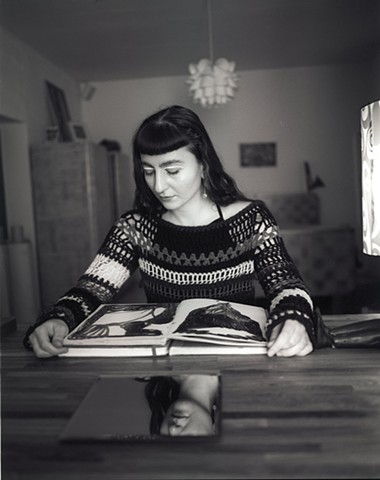Margo Sarkisova - Initiation
Where are you from and how does that affect your work?
My name is Margo Sarkisova, and I'm a Ukrainian artist with Assyrian roots. I was born in the small city of Pokrovsk, which is located in the Donetsk region, and this fact has really influenced my work and personality. I can say that a great impact on my life and artistic practice has been made by my dual national identity as Assyrian-Ukrainian, growing up in a small city of miners, and experiencing the Russian-Ukrainian war since its beginning in 2014.
Who are your biggest artistic influences?
I would say that my visual language has not been influenced by a certain artist. I have always been inspired and moved by periods of art history, and my favorite one since studying at the art academy in Kharkiv is Sumerian art and the period of Ancient Egypt. But honestly, I can say that I don't find inspiration for my art in certain personalities.
Where do you find inspiration?
In continuation of the previous question, I'm fascinated by mythology, dreams, fairy tales, and ancient art. Also, a big part of my concepts is born in the process of learning and reflecting on Tibetan Buddhism philosophy, which I started to learn in 2019. And if we talk about inspiration, I'm very moved by the opportunity to express the inner conflict about my two national identities and how they combine in myself and how they influence my worldview as a person and artist.
How can your work affect societal issues?
In my practice, starting with the work on the *6769 project, I started to reflect on the mentality of modern Assyrians. With this project, I formulated the question: "Does personality matter for culture?" Now I'm working on the second part of 6769, which came from the question: "What place do women hold in culture?" In it, I deal with the topic of male centrism and gender inequality that stems from the cultures of the East. I think that we need to shine a spotlight on women from Eastern cultures because unfortunately, there is still a lot of oppression against us. But by raising our voices, there is more opportunity to slowly change the situation for the next generations. And personally, I want to dedicate my art practice to this.
Does your work reflect your personal experience?
Definitely, as I mentioned before, probably the biggest part of my work is dedicated to reflecting on the inner conflict of being half Assyrian and half Ukrainian. With the beginning of the full-scale invasion of Ukraine in 2022, the question of the impact of war on my life and artistic practice became sharper, and for me, it felt like an attack on my identification as Ukrainian. My two identities have a very long and painful history. And now my biggest task is to find a way to express this experience to the outside world. But it is a journey of a lifetime.
This work is one of the most important series on my way to understand how the process of self-identification works. And over the years, I have found more and more meanings within it. From the beginning, it reflects the journey of the mythological "hero," who seeks to understand who they are, but this process takes place without the desire of the person. In my opinion, life simply puts this "hero" in circumstances where another way of life is impossible.
Tell us more about each Chapter and meaning behind the myth. A brief description.
I. Naiveness
ІІ. Apple tree
III. Pain
IV. Flower-identity
V. Ouroboros
VI. Gardener
So, the story begins with "Naiveness," the first piece, where we see a big hole in the heart of the person and eyes covered with an imaginary plant. I tried to show the blindness and the process of being held back by traumatic experiences without even realizing that fact.
The second one is "Apple tree," which tells us about the moments just before naiveness completely disappears in one moment. Here, I use the symbol of an apple tree as a metaphor for young and pure feminine nature, but you can see that the colors give us a disturbing feeling, and the roots of the tree are "naked" and placed on the shoulders of small humans. This symbolizes the burden of carrying culture as the responsibility of ancestors, which is a heavy burden.
The third work in the series is "Pain," which depicts the experience of all emotions that come after facing the truth. Small humans dancing around a crying couple depict negative thoughts and states, and the flower beneath them also has a special meaning for me. It's the real flower called "Crown Imperial." Since childhood, I have witnessed how this flower blooms for a short period of time, and its seeds were transferred from my great-grandmother to my grandmother and from her to my mother. It's a symbol of the continuation of traumatic experiences and unhealed wounds from women to women.
The fourth work, "Flower-identity," holds a special place in the series. In this work, I tried to imagine the face of a culture. It depicts culture as a Goddess and Mother who will hold and support you in times when you have nothing to lose. But at the same time, it gives you the most painful wounds that you can't escape from.
The fifth work, "Ouroboros," resulted from reflection on what a culture could face if it does not transform and remains stagnant. I imagined this process using the ancient symbol of the ouroboros, a snake that bites its own tail. It represents the never-ending circle of suffering, and I use it because I sincerely believe that if a culture does not progress and transform with the world, it will destroy itself from within and eventually disappear.
The last work in the series was born a few months after the first public presentation. Due to the new wave of lockdowns in 2020, my personal exhibition was closed for almost half a year. During this time, I reflected on the last stage of the series and felt that it couldn't end like that. And that's when "Gardener" was born. I was thinking about possible ways of preserving the traditions and rich history of Sumerians for the next generations, and I came up with the idea of a certain "worldview."
The mentality of a gardener became my answer to tough questions like how we can preserve authentic traditions without forcefully instilling culture in young people. The mentality of those who take care of their own little universe, nurturing it with love and patience so that a beautiful, flourishing garden can emerge. This is a metaphor for life itself, where seeds must also be sown at the right time to secure the future. I imagine the path of the gardener and their ritual "dance" around the future results of their everyday routine moves, trying to recreate this "choreography" of everyday patterns

